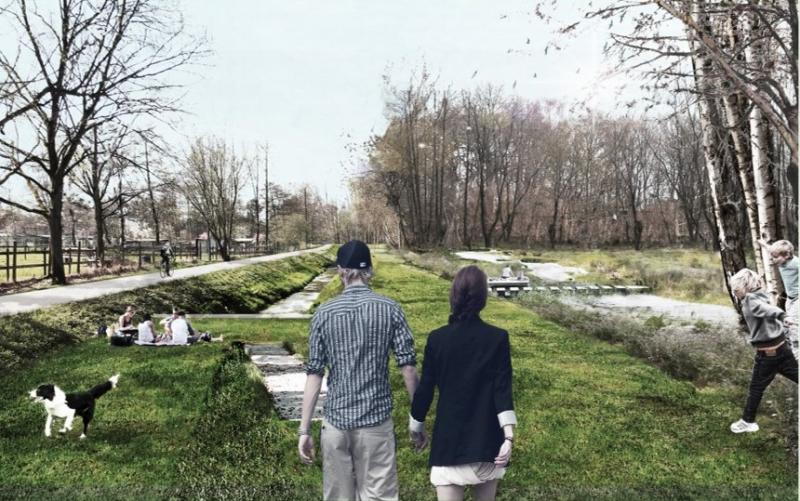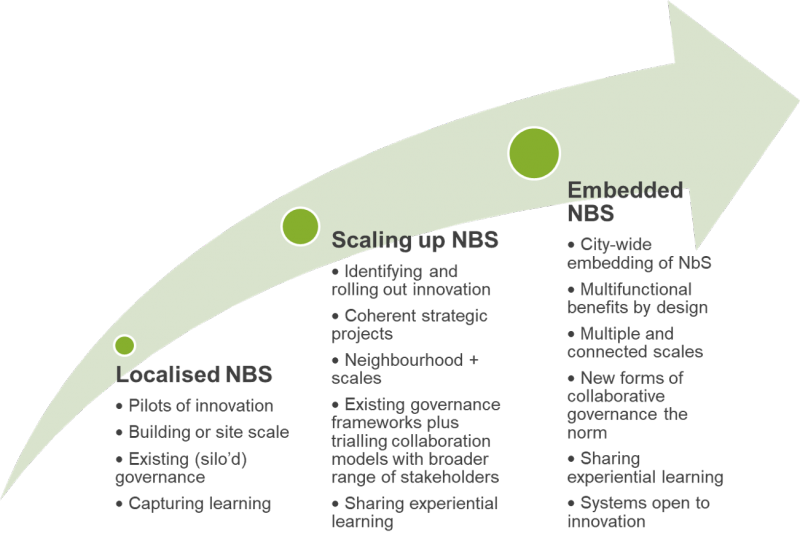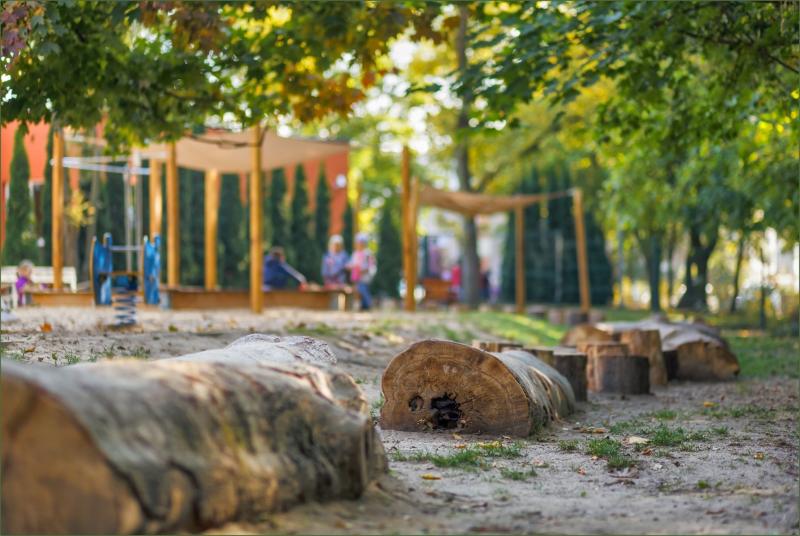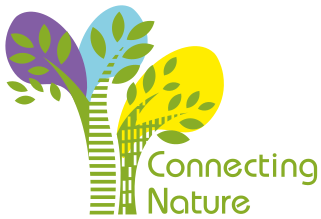Last week was our second EU evaluation on our Connecting NatureProject. Project evaluations are always a bit of a stressful time, but are so useful in terms of getting critical external input on our project progress, particularly in relation to the success of our delivery against our project ambitions. For any project this is a challenge but, when the ambitions of your project are to drive transformation in city-planning processes and systemic change in land management, demonstrating that you have met your ambitions is a particularly high bar to reach…
Connecting Nature is one of a raft of EU Horizon 2020 projects addressing the topic of nature-based solutions. One of the early projects under this theme, it was funded under a call that specifically required projects to drive scaling-up of nature-based solutions. Using a structure based on Front-runner Cities (cities that were more evolved in their nature-based solution delivery) and Fast-follower Cities (cities that were just beginning their journeys with nature-based solutions), the funding call concept was (fairly) straightforward: gather together all of the latest understanding on nature-based solution implementation; use it to explore scaled-up delivery in the Front-runner Cities; then take the learning from this and share it with Fast-follower Cities and beyond to unlock global rollout.

Glasgow City Council’s Open Space Strategy is one of the Connecting Nature Front-runner City nature-based solution exemplars. The strategy applies a nature-based solution lens onto the planning, delivery and stewardship of Glasgow’s Open Spaces.
In Connecting Nature, we have embraced this remit as a challenge and, as a consortium, we are working in a truly collaborative way to explore the multifaceted challenges of scaled up nature-based solution delivery. At the time of our first review, progress had been steady but slow, largely due to the interrelated complexities of driving such systemic change: Where to start? What has worked in the past, and why? What hasn’t? What foundations need to be in place? How do you address such substantial challenges as interdepartmental collaboration in organisations with little track-record of this? At the time of the first review, I think it is fair to say that our Front Runner Cities were still finding their feet, and felt less like Front-runner Cities and more like guinea pigs!

Genk City Council’s Stiemer Vallei programme is another of the Connecting Nature Front-runner City nature-based solution exemplars. The programme adopts a nature-based solution approach to the planning, delivery and stewardship of a degraded stream valley that runs through the heart of Genk connecting many key sites across the city. © City of Genk
At the time of our second review, however, progress has been strong. Our Front-runner Cities have all delivered transformative change in relation to nature-based solution scaling. This has included, significant advances in communication, support, and demonstration of scaled-up nature-based solution implementation. The lessons learned from these processes are being captured and shared between our Front-Runner Cities and Fast-Follower Cities, through peer-to-peer learning processes and Connecting Nature has produced and shared a range of innovative supporting tools and processes that translate the learning from the project into tools and techniques that support nature-based solution scaling. The objective of all of these outputs is to support more cities in the transformation from a situation whereby nature-based solutions represent innovative pilots of good practice to one where they are embedded in city-making processes and represent business as usual (see transformation journey Figure below). And, based on the transformation changes happening in our Front Runner Cities and Fast-Follower Cities, and on their testimonies during the recent evaluation, the collaborative approach of Connecting Nature and the tools it is producing are proving to be successful.

A representation of the transformative journey that cities are embarking on through the Connecting Nature Framework process. © Paula Vandergert (UEL)
Whether it is Glasgow’s Open Space Strategy, Genk’s Stiemer Vallei programme, Poznań’s out-scaling natural playgrounds programme, or any of the exemplars being developed across Europe in our Fast-follower Cities, there are valuable learning outcomes for any city (or indeed any other organisation) looking to expand the delivery of environmental, economic, and social benefits through a nature-based solution approach.
As highlighted in this recent evaluation, as a project, our challenges now are: to ensure that this learning is shared through our variety of dissemination platforms; to capture the impact as more stakeholders engage with and use Connecting Nature outputs; and to iteratively evolve our outputs based on the feedback of users to ensure they are relevant to as broad an audience as possible.

Poznań City Council’s out-scaling natural playgrounds programme is another of the Connecting Nature Front-runner City nature-based solution exemplars. The programme adopts an eco-education and play design approach to the open spaces surrounding pre-schools and schools across the city. © City of Poznań
The Connecting Nature website, Oppla nature-based solutions platform, CitiesWithNature initiative, , and EU Task Forces (that bring together all EU-funded nature-based solution projects to create collaborative outputs), are the main platforms through which we have been sharing Connecting Nature outputs.
Central to these platform resources is the scaling approach of the Connecting Nature Framework. This is a multidisciplinary framework that supports cities and other stakeholders in navigating the complexities of up-scaling and out-scaling nature-based solution delivery. The Framework is designed to support the planning, delivery and stewardship phases of scaled-up nature-based solution implementation.

Visual representation of the Connecting Nature Framework demonstrating how the different elements of the Framework interlink synergistically and iteratively to support the planning, delivery and stewardship phases on nature-based solution implementation
Emerging innovations from Connecting Nature are all aligned with this central Framework and cover a range of themes. Innovations include:
- Connecting Nature Framework Elements – the Framework is developed around seven separate elements: Technical Solutions, Governance, Financing and Business Models, Nature-based Enterprises, Co-production,Reflexive Monitoring, and Impact Assessment. Each Framework element comprises a series of guiding questions and processes to support the development of the topic area.
- Framework Guidebooks (Technical, Governance, Finance and Business Models, Nature-based Enterprises, Co-production, Reflexive Monitoring, and Impact Assessment) – framework guidebooks represent an introductory route into the Framework and each of the elements. They provide an overview to the strategy behind each element and an introduction to the steps involved and available supporting resources.
- UrbanByNature webinars – hosted on the CitiesWithNature YouTube channel, these webinars provide an experiential learning approach to knowledge transfer between cities in relation to the Framework elements and supporting processes. Focused on the first regional hubs in Brazil and the Caucasus, these webinars provide insight into how our Connecting Nature partners, and partners in these hub regions are addressing different aspects of the Framework.
- Nature-based solution business model canvas – an easy-to-use tool to help you capture in a visual format the business model of your nature-based solution.
- Nature-based Enterprise platform – a new platform (launched this week) to provide a marketplace for nature-based enterprises and nature-based organisations (yes, you can find out the difference between the two on the platform). The platform has been developed to provide a shopfront for such businesses, a central resource for emerging funding and tendering opportunities, and an open forum for communities of interest to share and discuss challenges in relation to nature-based solution planning, delivery and stewardship.
- The Sarajevo Co-creation process – a co-creative arts-based engagement approach that draws on our memories, places us in nature and captures our embodied experiences to help us tell our stories with/in nature.
- Evaluation Indicators – Connecting Nature partners have been co-developing a series of evaluation indicators under the themes of environmental, economic, social, and health & wellbeing benefits of nature-based solutions. The results of this co-development are being fed into an EU Task Force bringing project outputs from across EU-funded projects into a central evaluation indicators guidebook that will appear later in the year or early next year. The results of the Connecting Nature environmental indicators review has been published already.
At just over halfway through the project, there will certainly be more outputs and innovations to come, so keep an eye out here and on the Connecting Nature website. As they say in the trade though, the proof is in the pudding, so we encourage you to explore and adopt these resources. And, just as importantly, to feedback to us in terms of how they were used, how useful they are, and what else you would like to see coming from the project.
This blog was originally posted on UEL SRI news and views
